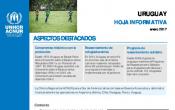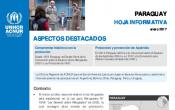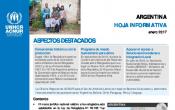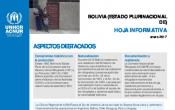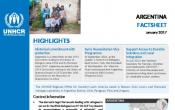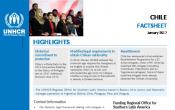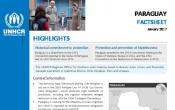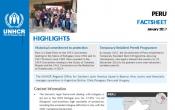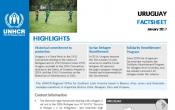Argentina Regional Office
The UNHCR Regional Office for Southern Latin America based in Buenos Aires covers operations in Argentina, Bolivia, Chile, Paraguay, Peru and Uruguay.
Operation: Argentina Regional Office
Location
{"longitude":-65,"latitude":-34,"zoom_level":4}
Latest update of camps and office locations 21 Nov 2016. By clicking on the icons on the map, additional information is displayed.
Key Figures
| 2016 end-year results | |
| 80% | of people of concern had formal access to work opportunitites in host country |
| 68% | of people of concern opting for local integration were locally integrated |
| 5 | out of the 6 countries covered by the Regional Office have taken steps to become party to the Statelessness Conventions |
| 2017 planning figures | |
| 80% | of people of concern will opt for local integration |
| 80% | of people of concern will realize a social and economic integration |
| 90% | of people of concern will have formal access to work opportunities |
Latest Updates
People of Concern
93%
Increase in
2016
2016
| 2016 | 20,175 |
| 2015 | 10,428 |
| 2014 | 9,668 |

[["Refugees",7981],["Asylum-seekers",12013],["Others of concern",181]]
Loading ...
Argentina Regional Office
< Back
2016
{"categories":[2012,2013,2014,2015,2016,2017],"budget":[4.41538441,4.3909691,4.38205254,5.149656436,4.81551835,5.89784793],"expenditure":[3.76308702,3.2805336,3.63853125,3.31968324,3.25705897,null]}
{"categories":[2012,2013,2014,2015,2016,2017],"p1":[4.41538441,4.26466431,4.31963749,5.063435816,4.64695957,5.74277446],"p2":[null,0.12630479,0.06241505,0.08622062,0.16855878,0.15507347],"p3":[null,null,null,null,null,null],"p4":[null,null,null,null,null,null]}
{"categories":[2012,2013,2014,2015,2016,2017],"p1":[3.76308702,3.15422915,3.57614911,3.23346262,3.10502305,null],"p2":[null,0.12630445,0.06238214,0.08622062,0.15203592,null],"p3":[null,null,null,null,null,null],"p4":[null,null,null,null,null,null]}
Loading ...
CHOOSE A YEAR
- 2015
- 2016
- 2017
Working environment
In the Southern Cone, 2016 was a year of economic and social challenges, with States facing growing unemployment rates in both public and private sectors. While still benefitting from an overall favourable protection environment, particularly with respect to access to health and education, refugees nevertheless encountered difficulties in finding permanent housing and livelihood opportunities to increase their self-reliance.The Brazil Declaration and Plan of Action (BPA) have boosted the protection agenda and regional cooperation in the Southern Cone. Follow-up mechanisms were put in place and specific work plans were elaborated with States to implement key BPA programmes: 1) Quality Assurance Initiative (QAI) for asylum systems in Argentina, Bolivia, Chile, and Peru; 2) Borders of solidarity and safety at the Bolivia-Chile-Peru border and initial monitoring activities towards achieving this at the Paraguay-Brazil border; 3) Livelihoods programmes were prioritised in Argentina, Bolivia, Chile and Peru; 4) Resettlement and humanitarian visa programmes were supported.
Countries in the region also continued to demonstrate solidarity in response to the Syria crisis and other humanitarian situations worldwide.
Population trends
- At the end of 2016, the number of refugees and asylum-seekers in the region reached 20,000, an increase of 87 per cent compared to 2015, due to a considerable increase of new asylum applications in Argentina, Chile, Peru and Uruguay. Official government statistics include for the first time applications under appeal/administrative review and/or judicial review in Argentina, which represent 53 per cent of the asylum applications pending a final decision.
- People of concern (PoC) in the region are primarily from the Latin America, mainly Colombia and Venezuela, but also from Africa (mainly Senegal and Nigeria) and Syria. Approximately 27 per cent of the new arrivals in 2016 were Colombians, mostly in Chile, followed by Venezuelans in Peru, people from Senegal in Argentina, and Syrians in Bolivia and Paraguay.
- Approximately 38 per cent of the PoC were female and around 20 per cent were assisted by UNHCR in the areas of basic humanitarian assistance, documentation, language, education at primary and secondary levels, vocational training, as well as legal and social counselling.
Achievements and impact
- In line with the BPA, governments assumed more responsibilities to facilitate local integration by: 1) increasing financial support for PoCs; 2) incorporating POCs into several social protection schemes including for housing, alimentation, and child allowance; and 3) working to develop public policies for assistance to PoC at national and local levels.
- The Office continued to support governments in the region to implement the BPA, exchange best practices, and incorporate protection safeguards in existing migratory systems.
- UNHCR exercised its supervisory role and delivered technical support and advice on RSD procedural standards and eligibility criteria through the QAI.
- The Office actively promoted the implementation and expansion of resettlement and other humanitarian admissions schemes to pursue durable solutions for refugees.
- UNHCR supported local protection networks to improve the protection situation at the border areas of Bolivia, Chile and Peru.
Unmet needs
- Basic humanitarian assistance could only be provided for the most vulnerable people of concern and for a limited period of time, falling short of UNHCR standards and directly impacting on people with specific needs, such as children, elderly, women at risk, single parents, people in need of psychosocial support or with disabilities, and survivors of sexual and gender-based violence (SGBV).
- Access to housing remains a critical unmet need. PoC are often forced to live in the outskirts, in slums or overcrowded dwellings without proper access to basic services.
- The need for a regional child protection strategy remains, in order to ensure the coordination and response by governments in the region to respond to unaccompanied asylum-seeking children, including reception and care, as well as legal representation.
UNHCR’s Regional Office in Argentina covers activities in Argentina, Bolivia, Chile, Paraguay, Peru and Uruguay.
Operational context and population trends
In the last decade, countries covered under UNHCR’s office in Buenos Aires – Argentina, Bolivia, Chile, Paraguay, Peru and Uruguay – have developed a comprehensive legal framework for the protection of refugees, and the respective National Refugee Commissions have assumed full responsibility for refugee status determination (RSD) procedures in these countries. Five out of the six countries are party to the Statelessness Conventions.The main challenge in the coming years will be to effectively achieve comprehensive, complementary and sustainable solutions for refugees. Based on the very solid legal and institutional frameworks in the Southern Cone, states have the opportunity to assume a leading role in the promotion of local integration policies and livelihood opportunities for refugees in coordination with local governments, NGOs and the private sector. The development of comprehensive local integration mechanisms will also facilitate implementation of sustainable resettlement and humanitarian visa programmes for refugees from inside and outside the region (e.g. Middle East, Africa).
At the end of 2015, the population of concern to UNHCR in the region stood at some 10,700 individuals, 34 per cent of whom were female. Given current trends in the region, it is estimated that by the end of 2016, the number of people of concern will have reached around 13,200 refugees and asylum-seekers, mostly from the Latin America subregion – although there are also people of concern from Africa (primarily from Senegal and Nigeria), as well as an increasing number of new arrivals from Syria.
Key priorities in 2016
Within the framework of the Brazil Plan of Action (BPA), UNHCR’s key priority is to consolidate a regional protection space in the Southern Cone by pursuing the following objectives:- Achieve high international protection standards as a foundation for sustainable comprehensive, complementary and innovative durable solutions for all people of concern;
- Work closely with countries assuming leadership roles in the implementation of the BPA in South America, within the framework of regional integration mechanisms such as MERCOSUR. Special efforts will be aimed at promoting state leadership in local integration strategies;
- Support UNHCR’s regional and global agenda, through resettlement and other humanitarian admission schemes developed by relevant countries.
- Promoting the consolidation of the National Refugee Commissions’ Presidents Refugee Forum (within MERCOSUR) for the implementation of the BPA, the exchange of best practices, as well as the incorporation of protection safeguards in existing migratory systems;
- Enhancing and strengthening the asylum system in the region through the Quality Assurance Initiative (QAI), a tool applied by countries with the support of UNHCR to examine and improve their existing systems;
- Raise awareness on regional and global crises, such as those unfolding in the Middle East and Africa, to promote UNHCR´s agenda in the Southern Cone through resettlement opportunities, fundraising opportunities, and south-south cooperation for countries to share their best practices and lessons learned.

